Ijraset Journal For Research in Applied Science and Engineering Technology
- Home / Ijraset
- On This Page
- Abstract
- Introduction
- Conclusion
- References
- Copyright
Sky-Hub: Advanced Video Conferencing with Real-Time Collaboration
Authors: B K Sheshadri, B Sneha, D Kavya, K S Harsha, Kavyasree K
DOI Link: https://doi.org/10.22214/ijraset.2025.66204
Certificate: View Certificate
Abstract
The Sky-Hub Project is a video conferencing app designed for seamless remote communication through video, audio, and chat. It supports virtual meetings, collaborations, and events. Key features include dynamic room creation, real-time call quality monitoring, and adaptive video quality based on network speed. Unique tools like Video Summarization provide meeting highlights, while Call Latency Monitoring ensures connection reliability. With a responsive design for all devices, the app offers low-latency communication and scales for multiple users. Customizable and cost-effective, it’s a robust solution for personal, professional, and educational use.
Introduction
I. INTRODUCTION
In today’s fast paced digital world, staying connected through virtual communication can be challenging. That’s where our Sky-Hub project comes in a thoughtfully designed video conferencing app aimed at making virtual interactions easier and more efficient. This app offers practical features to address common communication issues. For instance, it uses real-time analytics to monitor and optimize call latency, ensuring meetings run smoothly without unnecessary interruptions. Whether you’re collaborating with a team, hosting a class, or catching up with friends, the app is designed to provide a reliable and seamless experience.
One of its most helpful features is video summarization. Instead of spending time reviewing long meeting recordings, users receive concise, text-based summaries that highlight key points. This feature not only saves time but also helps users stay organized and productive. With its simple and user-friendly interface, this project makes virtual collaboration more accessible and efficient. Designed for work, education, and personal use, it’s an effective solution for staying connected in a way that’s both practical and intuitive. This app isn’t just about virtual meetings it’s about improving how we communicate in a digital world.
II. LITERATURE REVIEW
A. Video Conferencing
Video conferencing is a method of communicating between two or more locations in which sound, vision, and data signals are conveyed in an electronic way to enable continuous interactive communication. VC is much more personal and effective than audio conferencing, all the parties which are being involved in that meeting can see the expressions, especially facial expressions and body language which are so important and vital to the way we communicate. Video conferencing works by using various technologies. A Video conference can be between two sites, which means locations that are connected to each other via the video conference, or the conference can connect multiple locations. Video conferencing communication can take place in a special video conferencing studio or o a normal computer with a webcam or on a video call on mobile phones. Besides audio and video transmission of the meeting’s activities, video conferencing technologies can be used to share data, and documents and display information.
B.Video Conferencing Web Application Using WEBRTC
This project explains how to solve the problem by creating a similar web application that uses WebRTC. Web Real-Time Communications (WebRTC) is an Application Programming Interface that allows web developers to integrate Real-Time Communication (RTC) capabilities into their web-based applications without the need for plugins. Peer-to-peer (P2P) architecture is superior to client-server design in terms of scalability and reliability, as single nodes failure does not effect the entire system. In addition, the WebRTC system consists of a web server and browser that run on many operating systems, as well as workstations, tablets, and mobile phones. The Role of Lullabies in Emotional and Cognitive Development
C. Quality of Experience in Telemeetings and Videoconferencing
Telemeetings such as audiovisual conferences or virtual meetings play an increasingly important role in our professional and private lives. For that reason, system developers and service providers will strive for an optimal experience for the user, while at the same time optimizing technical and financial resources. This leads to the discipline of Quality of Experience (QoE), an active originating from the telecommunication and multimedia engineering domains, that strives for understanding, measuring, and designing the quality experience with multimedia technology. This paper provides the reader with an entry point to the large and still growing field of QoE of telemeetings, by taking a holistic perspective, considering both technical and non-technical aspects, and by focusing on current and near-future services. Addressing both researchers and practitioners, the paper provides a comprehensive survey of factors and processes that contribute to the QoE of telemeetings, followed by an overview of relevant state-of-the art methods for QoE assessment. To embed this knowledge into recent technology developments, the paper continues with an overview of current trends, focusing on the field of extended Reality (XR) applications for communication purposes. Given the complexity of telemeeting QoE and the current trends, new challenges for a QoE assessment of telemeetings are identified.
D. Real-Time Video Conferencing Application
Mobile learning tools have facilitated authentic learning experiences, allowing students to forge meaningful connections while acquiring real-world knowledge. Mastering the skill of using mobile video conferencing applications is crucial but often complicated for users, such as students, teachers, and employers. In this study, the mobile video conferencing applications Zoom and Webex were compared with respect to their usability, using cognitive load theory as the conceptual framework. A systematic mapping approach was applied to obtain comparative descriptive information from surveyed literature. The available literature on communications support, accessibility and usability, and privacy and security of video conferencing technology was used for the systematic mapping process. The literature review revealed that Zoom and Webex usage can lead to cognitive fatigue, so users must avoid multitasking and schedule breaks between sessions to remain focused. Furthermore, video conferencing tools need to bridge the gap between usability and security for augmented safety of personal information alongside user comfort. Overall, the findings of this study are important for reducing the complexities of mobile video conferencing applications and enhancing the mobile learning experience.
III. PROBLEM DEFINITION
The creation of a flexible video conferencing platform with advanced solutions for more efficient remote meetings. Real-time call latency can be monitored in this platform, ensuring smooth and uninterrupted conversations as it adjusts according to the network traffic. This dynamic solution automatically controls resolution and bitrate based on network bandwidth while reducing the number of interruptions, maintaining an ideal user experience with a dynamic video quality optimization solution. For improved usability, the platform's AI Automatically summarize the video, creating a concise meeting recap and instantaneously identifying and highlighting crucial points, decisions, and action items. To save time, help remember info and make follow-ups easier. It also integrates must-have collaboration tools, like screen sharing, integrated chat and file sharing, to create a unified environment for your team. End-to-end encryption is the primary encryption method the architecture uses to ensure user data anonymity and a scalable infrastructure to support fluctuating user demand. It has a user-friendly interface and built-in analytics for insights on meeting performance and user engagement. By providing a unique combination of adaptive technology and AI-driven enhancements, this solution solves for many challenges of remote communication while allowing for a productive, reliable and intuitive video conferencing experience in both professional and educational use cases.
IV. METHODOLOGY
The Sky-Hub project is designed to offer a seamless and secure virtual meeting experience. It starts with a simple yet secure login process, where users enter their credentials, verified through an authentication service. Once logged in, users land on a dashboard a central hub where they can easily access features like "Join Meeting", "Create Meeting," or "View Meeting History." Creating a new meeting generates a unique meeting ID and invite link, while joining one requires entering an ID and password. The platform ensures secure access, assigning roles such as host or participant for smooth meeting management. During meetings, users can enjoy real-time video and audio streaming, text chat, and screen sharing. The system actively monitors call latency, offering real-time feedback to ensure smooth communication. Adaptive bitrate streaming dynamically adjusts video quality based on network bandwidth, providing uninterrupted interactions. Users can leave anytime, or the host can end the meeting for everyone.
After the meeting, the platform processes the recording for summarization. Using machine learning, it identifies key moments like important discussions or decisions and generates a short video summary. This saves time by highlighting the most critical parts of the meeting. Both the full recording and the summary are available on the dashboard or sent via email for convenience. Additional features include meeting history, feedback collection, and easy access to recordings or summaries. This end-to-end solution prioritizes security, low latency, and advanced summarization, creating an efficient and user-friendly meeting experience.
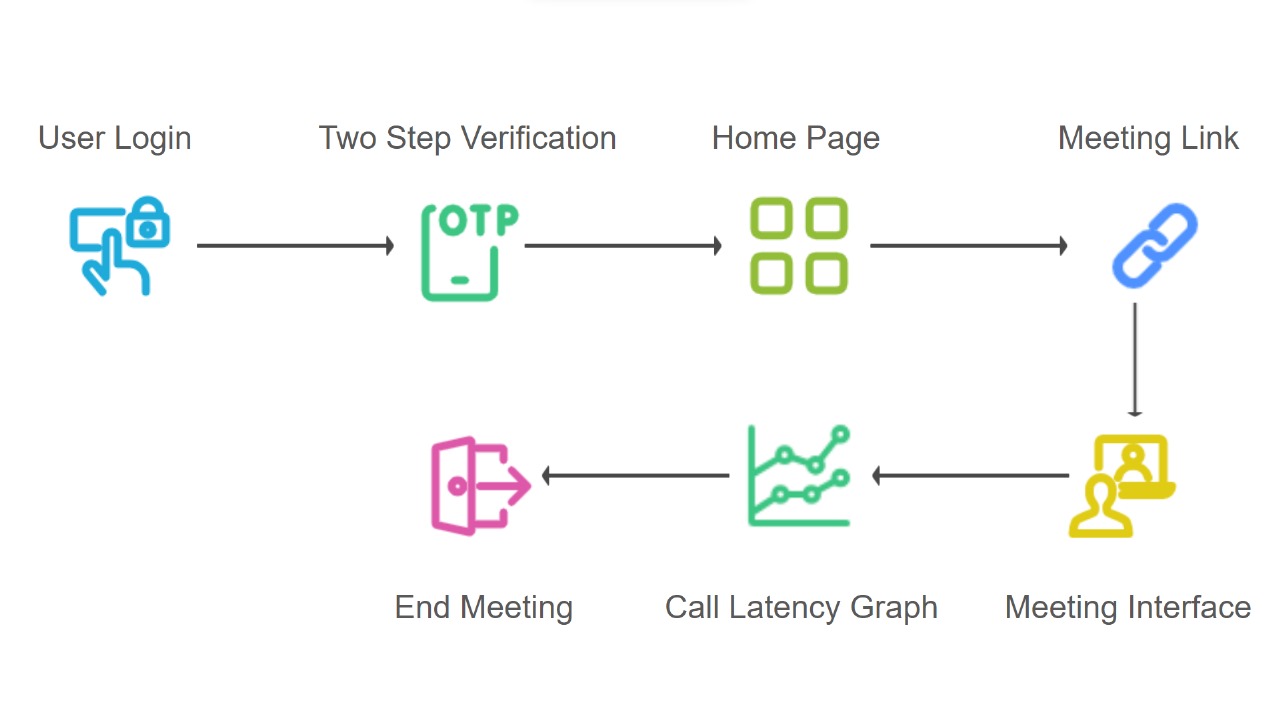
Figure 1 Sky-Hub workflow
V. RESULTS AND EVALUATION
The output of this project is a fully functional web-based video conferencing platform that prioritizes seamless communication, efficiency, and user friendly. This platform allows users to conduct real-time video and audio communication, participate in text-based chats, and share screens during meetings. It supports dynamic meeting room creation and management, enabling users to join or host secure and scalable virtual meetings. Key outputs include real-time call latency monitoring, which provides users with live feedback about their network's performance, ensuring smooth and uninterrupted communication. Another significant feature is video summarization, which processes recorded meetings to identify and compile key moments into a concise video summary, allowing users to quickly review essential discussions and decisions. This summary is accompanied by the full recording for detailed reference.
Additionally, the platform generates user-friendly reports such as meeting histories, video summaries, and participant attendance, enhancing post-meeting productivity. The output also ensures high scalability, supporting multiple concurrent users, and guarantees reliable and secure communication with encryption protocols in place. Overall, the project delivers an advanced, feature-rich video conferencing system tailored to meet modern communication needs effectively.
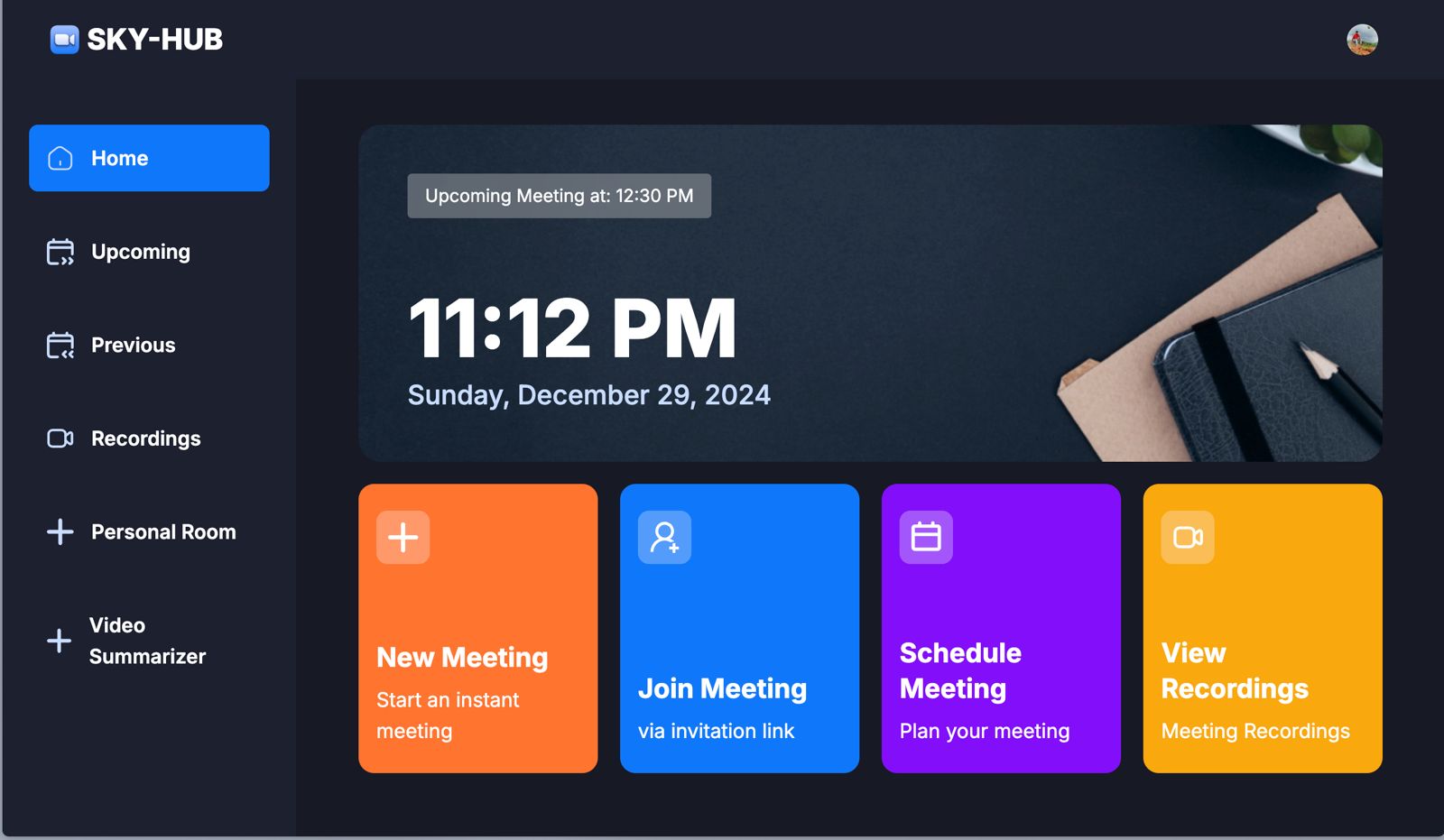 Figure 2 Home page
Figure 2 Home page
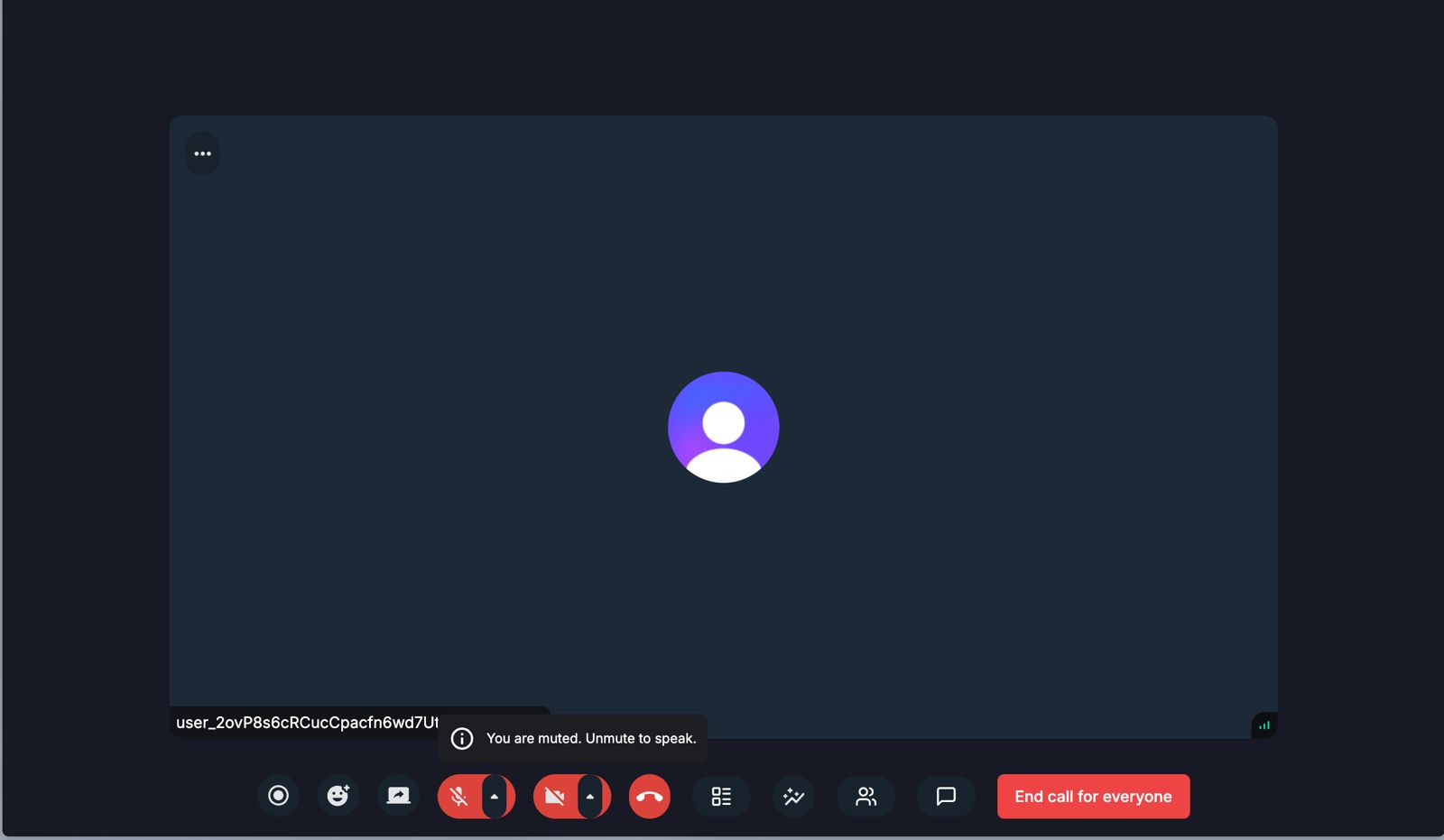 Figure 3 Meeting room
Figure 3 Meeting room
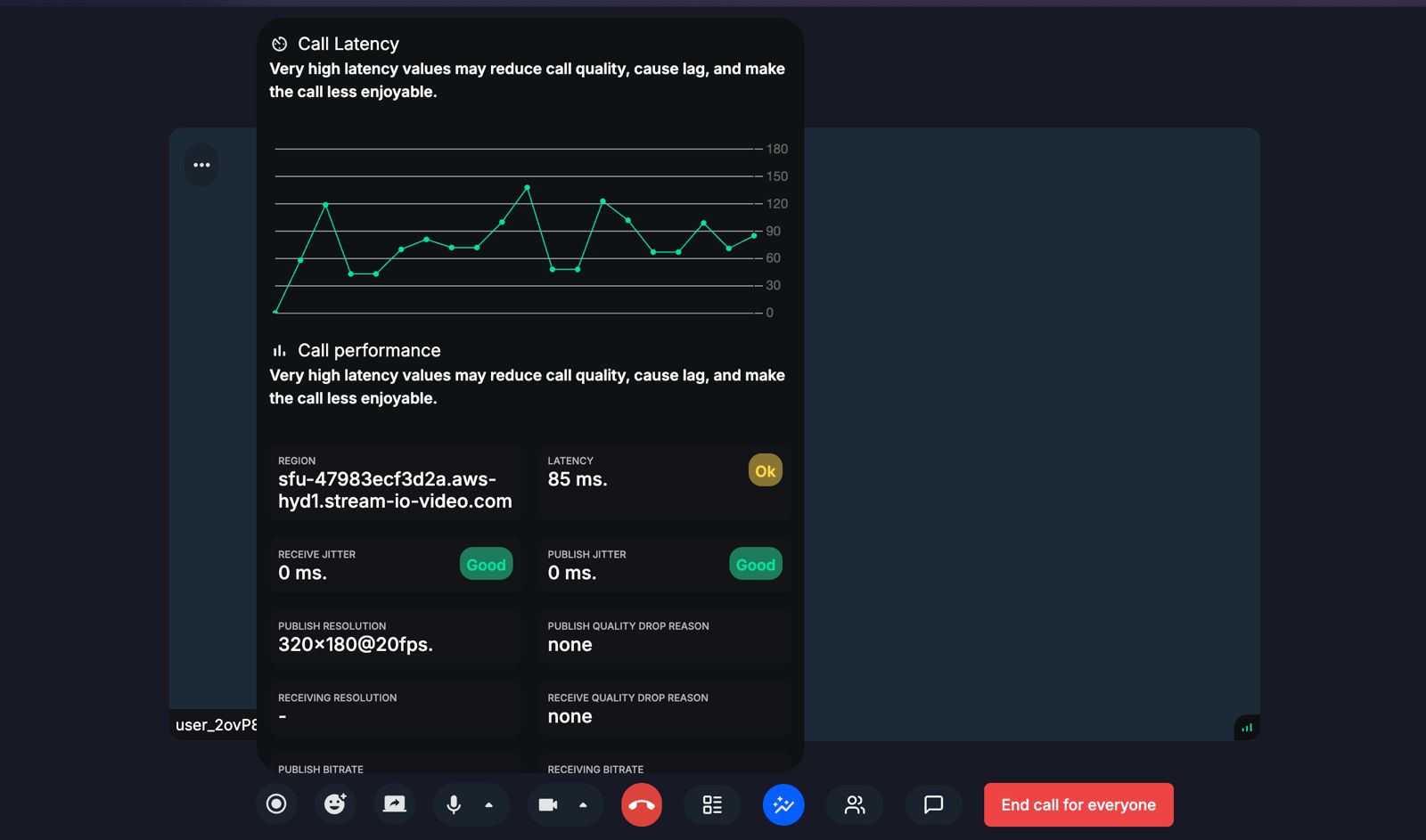 Figure 4 Call Latency
Figure 4 Call Latency
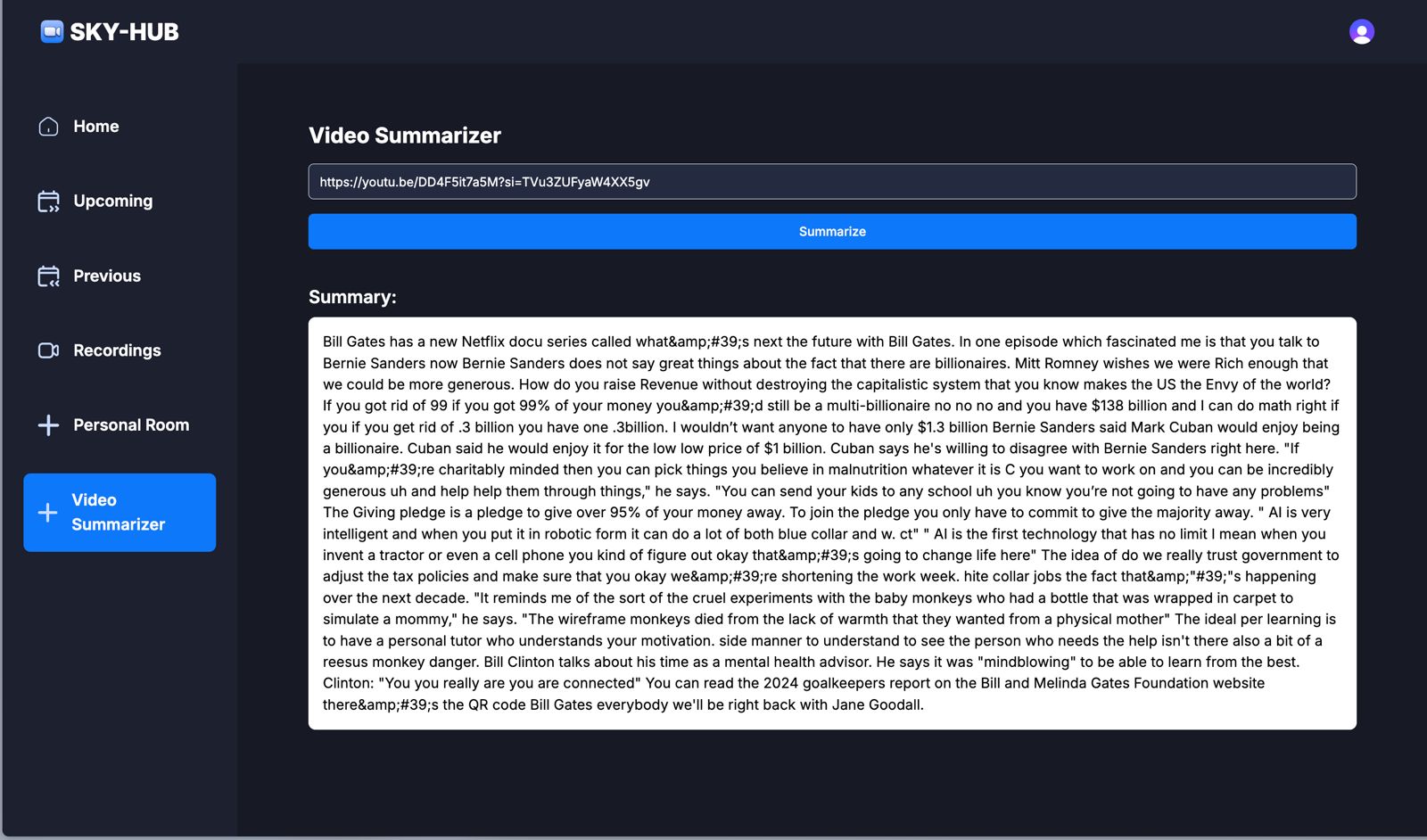 Figure 5 Video Summarizer
Figure 5 Video Summarizer
Conclusion
As virtual communication becomes an essential part of our daily lives, there’s a growing need for tools that enhance user experience and productivity. Our project addresses this by introducing a system designed to monitor call latency, maintain high quality video and audio, and create concise video summaries. These features not only improve the quality of virtual meetings but also make it easier for users to review and manage their discussions effectively. This solution is tailored for professionals, educators, and organizations, helping them save time, stay organized, and communicate more efficiently. By ensuring seamless interactions and offering tools to revisit key moments from meetings, we aim to make virtual communication more accessible and impactful. In essence, our project takes a meaningful step toward building a more connected and productive digital environment, empowering users to thrive in today’s fast paced, digitally driven world.
References
[1] G. J. Sullivan, J.-R. Ohm, W.-J. Han, and T. Wiegand, ``Overview of the high efficiency video coding (HEVC) standard,\'\' IEEE Trans. Circuits Syst. Video Technol., vol. 22, no. 12, pp. 1649_1668, Dec. 2012, doi: 10.1109/TCSVT.2012.2221191. [2] C. B. Kumar, A. Potnis and S. Gupta, \"Video conferencing system for distance education,\" 2015 IEEE UP Section Conference on Electrical Computer and Electronics (UPCON), 2015, pp. 1-6, doi: 10.1109/UPCON.2015.7456682. [3] S. Yoon, T. Na and H. -Y. Ryu, \"An implementation of web-RTC based audio/video conferencing system on virtualized cloud,\" 2016 IEEE International Conference on Consumer Electronics (ICCE), 2016, pp. 133-134, doi: 10.1109/ICCE.2016.7430552. [4] W. Mack and E. A. P. Habets, ``Deep filtering: Signal extraction and reconstruction using complex time-frequency filters,\'\' IEEE Signal Process. Lett., vol. 27, pp. 61_65, 2020. [5] N. Nartiningrum and A. Nugroho, “Online Learning amidst Global Pandemic: EFL Students’ Chal¬lenges, Suggestions, and Needed Materials,” EN-GLISH Fr. Acad. J. English Lang. Educ., vol. 4, no. 2, p. 115, 2020, doi: 10.29240/ef. V4i2.1494. [6] Parbat, G. V., Daruwala, A. A., Joshi, O. V., Singh, A. S., & Nalavade, K. C. (2021). A Review of MyFrames – Video Conferencing Web Application Using WebRTC. International Journal of Creative Research Thoughts (IJCRT), 9(11), 128-129. [7] S. Deokate, J. Chandivade, P. Sonawane, S. Dange, and P. Shriwastav: “Real-Time Video Conferencing Application,” International Journal of Creative Research Thoughts (IJCRT), vol. 10, no. 11, pp. c212–c218, Nov. 2022. ISSN: 2320-2882. [8] N. Samrgandi: “Privacy, Security, and Usability of Mobile Video Conferencing Applications: A Comparative Study,” International Journal of Advanced and Applied Sciences, vol. 10, no. 11, pp. 109–116, Nov. 2023. DOI: 10.21833/ijaas.2023.11.014. ISSN (Online): 2313-626X.
Copyright
Copyright © 2025 B K Sheshadri, B Sneha, D Kavya, K S Harsha, Kavyasree K. This is an open access article distributed under the Creative Commons Attribution License, which permits unrestricted use, distribution, and reproduction in any medium, provided the original work is properly cited.

Download Paper
Paper Id : IJRASET66204
Publish Date : 2024-12-31
ISSN : 2321-9653
Publisher Name : IJRASET
DOI Link : Click Here
 Submit Paper Online
Submit Paper Online

